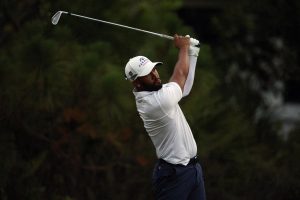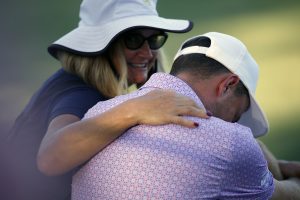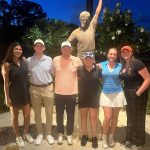Inside ‘Golf’s Longest Day’: The Grueling Final-Round U.S. Open Qualifiers

By Chandler Hawkes, Sports@CJC
JUPITER, Fla. — In the golf world, the final round of U.S. Open qualifying is better known as ‘Golf’s Longest Day.’
Many consider those final-round qualifiers to be one of the sport’s most grueling tests due to its demanding 36-hole, one-day format and the magnitude of what’s at stake for the golfers.
On Monday, 10 final-round qualifiers took place concurrently all across North America, nine in the United States and one in Canada. In all, 937 golfers — a mix of non-exempt PGA Tour pros, LIV Tour members and amateurs — competed across 13 different final-round sites with 68 total qualifier spots up for grabs in next week’s U.S. Open in Pinehurst, North Carolina. In Jupiter, Florida, 71 golfers competed at The Bear’s Club seeking to secure one of the qualifier’s five available spots.
It is the ultimate physical and mental test, and to be one of the last few golfers standing that makes it into the U.S. Open requires quite a performance on all fronts in order to be successful.
A few overarching themes from the players who have experienced this include being patient, having a caddie who knows you, and remaining present in the moment.
Former University of Florida golfer Chris Nido, who played for the Gators golf team from 2017-20 before turning pro, echoed the importance of remaining patient on such a long day. Nido was one of three former UF golfers who attempted to qualify in Jupiter, joining 2023 national champion Fred Biondi and Brett Stegmaier (2002-06).
“It’s a very long day, and I can feel it in my feet right now,” Nido said. “[You have to] just stay super patient and know that you’re gonna get bad breaks, and you’re gonna get good breaks. It’s, like you said, the longest day in golf, so just stay patient and see where your game puts you.”
Nido finished with a 1-under-par score of 143 for both of his rounds, leaving him just outside of the cutline, which was 3-under.
In a 36-hole event, course evolution is a key factor throughout the day. The course will play differently in the morning than it will in the afternoon, and there is a very short break in between rounds. Current UF sophomore golfer Parker Bell hinted at why being patient is so important with regard to that.
“You had to kinda go straight into the second 18, and I just tried to stay patient the whole time,” Bell said. “I honestly thought the scores were gonna be lower than they ended up being, but once the afternoon hit, the greens just got super firm, and it got super windy.”
After qualifying via a seven-man playoff in Dallas, Texas, at the Dallas Athletic Club, beating out guys like Masters winner Sergio Garcia and PGA Tour pro Kevin Streelman, Bell will be playing in his first U.S. Open at the age of 20. He fired a 3-under-par score of 139 on the day to secure his spot.
https://twitter.com/TexasGolfAssoc/status/1792908852683231477
On such a long day, the player’s caddie is instrumental in keeping the player focused through the rounds’ ups and downs. Whether it is keeping the mood light, talking the player out of a shot, or helping read the greens, their role is crucial. Many players will use their close relatives, best friends, or even just someone who has caddied for them for a while.
Willie Mack III, a journeyman pro from Flint, Michigan, needed some brotherly advice to help him survive the Jupiter qualifier and earn his first U.S. Open berth. Mack’s brother was on his bag and helped him make what was probably the most important decision of their day. Mack needed a birdie on the final hole of the second round in order to make a playoff for the final U.S. Open qualifying spot.
At The Bear’s Club, the par-5 18th hole is reachable in two shots as long as you hit a good drive. Mack stood on the tee box at 18 with his driver in his hands when his caddie and brother stepped in and made a suggestion that helped get Mack to Pinehurst.
“I wasn’t hitting my driver too well today,” Mack said. “I tried to hit a draw, I usually play a fade, and I asked my brother if I should hit the draw and try to get a little more distance, and he’s like, no.”
Mack would play the fade, proceed to make birdie to get to 3-under and sneak into a three-man playoff for Jupiter’s final Open spot. In the playoff, while chasing daylight, he beat out two amateur golfers — Auburn’s Brendan Valdes and Alabama’s Thomas Ponder — in two playoff holes to earn his first major appearance.

Mack finished the playoff at just after 8:30 p.m. — more than 12 hours after teeing off in his opening round.
For Mack, who played collegiately at Bethune-Cookman in Daytona Beach, Florida, it’s the culmination of a long road. Early in his career, Mack slept in his car for a year and a half to save money, and he lost his Korn Ferry Tour card last year.
But after grinding out 38 holes, he’s headed to Pinehurst.
“I probably needed this to prove I can play out there,” Mack said. “It’s been a long journey. This is my 12th year playing professional golf and this is my first major. I’m sure I’ll soak it all in. It will be super exciting, not only for me, but for my family.”
The big piece to the puzzle for players who are playing the final holes of the round, knowing they are on the border of qualifying, is making sure to remain present at the moment and not let your mind think about what lies ahead at the end of the tunnel.
Luke Clanton, a sophomore golfer at Florida State, was coming off a great college season with the Seminoles. He was the nation’s No. 2-ranked college golfer and earned first-team All-American honors. Just five days after leading the ‘Noles to the national championship match against Auburn in Carlsbad, California, he was in Jupiter, Florida, trying to qualify for his first major championship.
Clanton said that the hardest part of his day was constantly staying mentally in the rounds, knowing he was closing in on one of his dreams.
“When you realize that you got a chance to make the U.S. Open, it’s hard not to kinda picture it,” Clanton said. “I think [his caddie] Gabe helped me out a lot with the last nine holes, kind of knowing that I had to make a couple birdies coming in.”
Clanton stepped onto the 18th tee box at 4-under for his two rounds and one shot clear of the cutline. He knew a birdie on the 18th would almost certainly lock up his spot at Pinehurst.
After reaching the green in two shots and a great lag putt, with friends and family looking on, Clanton poured in the birdie putt, topped off with an emphatic fist pump, to shoot a 5-under-par total of 139.

After his round, Clanton sat behind the 18th green for about 10 minutes with his mom right by his side, realizing his dream together.
“I mean, she’s been there for four years straight, you know, at every event,” Clanton said with a face filled with emotion. “So, you know, I don’t want to get choked up by it, but it’s pretty cool, man. It’s awesome.”
Tackling ‘Golf’s Longest Day’ is no easy task combined with all of the outside factors, but everyone breathes a sigh of relief after it’s over — especially those who qualify.
“I’m tired, man,” Clanton said. “I’m ready to go home and sleep.”
Category: Covering the U.S. Open
Tagged: 2024 U.S. Open Covering the U.S. Open
Subscribe to our News Digest


